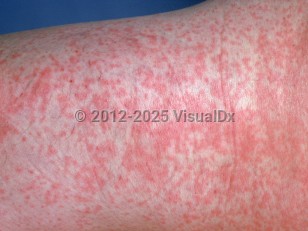Rubella in Child
Alerts and Notices
Important News & Links
Synopsis

Rubella (German measles) is caused by the rubella virus, which is an RNA virus in the Togaviridae family. Transmission is through the respiratory route. Its incubation period is 14-21 days. A prodrome of irritability, malaise, mild conjunctivitis, headache, fever, adenopathy, and minimal respiratory symptoms may appear 1-7 days prior to the cutaneous eruption. An exanthematous eruption starts on the face, spreads caudally, becomes generalized in 24 hours, and then typically disappears within 3 days. The palms and soles are typically, but not always, spared. This rash may be absent in as many as 25% of cases.
Infection in the United States is rare, owing to widespread vaccination. There is a higher incidence in confined populations such as military bases and schools. The disease is more common in the spring and summer. Arthralgias and mild arthritis, splenomegaly, thrombocytopenia, and testicular pain are sometimes seen. Encephalitis occurs in 1 out of 6000 cases. Pain on lateral or upward eye movement is common in this disorder. Thrombocytopenic purpura is also a rare complication.
Even in the immunocompromised host, rubella is usually a benign illness. The major impact of rubella is on the fetus of a pregnant patient and is one of the TORCH (toxoplasmosis, other [syphilis, varicella zoster, parvovirus B19], rubella, cytomegalovirus, and herpes simplex) diseases. These disorders can cause fetal heart and eye malformations, cataracts, deafness, intellectual disability, thrombocytopenic purpura, hepatosplenomegaly, intrauterine growth retardation, interstitial pneumonia, myocarditis, myocardial necrosis, and metaphyseal bone lesions.
Infection in the United States is rare, owing to widespread vaccination. There is a higher incidence in confined populations such as military bases and schools. The disease is more common in the spring and summer. Arthralgias and mild arthritis, splenomegaly, thrombocytopenia, and testicular pain are sometimes seen. Encephalitis occurs in 1 out of 6000 cases. Pain on lateral or upward eye movement is common in this disorder. Thrombocytopenic purpura is also a rare complication.
Even in the immunocompromised host, rubella is usually a benign illness. The major impact of rubella is on the fetus of a pregnant patient and is one of the TORCH (toxoplasmosis, other [syphilis, varicella zoster, parvovirus B19], rubella, cytomegalovirus, and herpes simplex) diseases. These disorders can cause fetal heart and eye malformations, cataracts, deafness, intellectual disability, thrombocytopenic purpura, hepatosplenomegaly, intrauterine growth retardation, interstitial pneumonia, myocarditis, myocardial necrosis, and metaphyseal bone lesions.
Codes
ICD10CM:
B06.9 – Rubella without complication
SNOMEDCT:
36653000 – Rubella
B06.9 – Rubella without complication
SNOMEDCT:
36653000 – Rubella
Look For
Subscription Required
Diagnostic Pearls
Subscription Required
Differential Diagnosis & Pitfalls

To perform a comparison, select diagnoses from the classic differential
Subscription Required
Best Tests
Subscription Required
Management Pearls
Subscription Required
Therapy
Subscription Required
References
Subscription Required
Last Reviewed:03/19/2023
Last Updated:04/03/2023
Last Updated:04/03/2023
 Patient Information for Rubella in Child
Patient Information for Rubella in Child
Premium Feature
VisualDx Patient Handouts
Available in the Elite package
- Improve treatment compliance
- Reduce after-hours questions
- Increase patient engagement and satisfaction
- Written in clear, easy-to-understand language. No confusing jargon.
- Available in English and Spanish
- Print out or email directly to your patient
Upgrade Today

Rubella in Child

